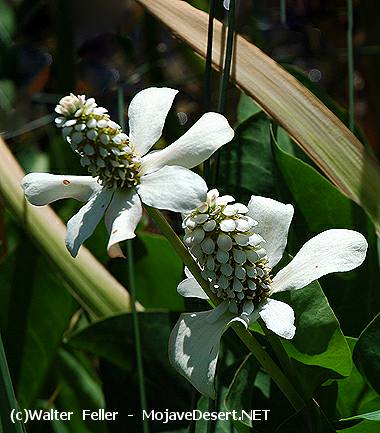Yerba Mansa
Anemopsis californica (Nutt.) Hook. & Arn.
4-20 inches highHabitat Wet, especially somewhat alkaline or saline marshy places, below 6500 feet
Alternate Names
Bear root
Scientific Name: Anemopsis californica
Common Name: Bear Root
Height: 4-20 inches tall
Habitat: Wet, marshy areas with alkaline or saline soils, below 6,500 feet
Range: Found in California (Mojave Desert, valleys, Channel Islands), Utah, Arizona, Texas, Colorado, and more
Plant Description:
No true petals, but white bracts (often reddish-tinged).
Spicy-scented leaves.
Creeping aromatic rhizomes (roots).
Uses:
Medicinal: Treats colds, coughs, stomachaches, ulcers, and more.
Disinfectant: Powdered plant used on wounds.
Food: Seeds used for mush or bread by Kamia people.
Propagation: Grows from fleshy roots; spreads quickly.
Care: Requires moist soil, full sun, and periodic weeding.
Cultural Importance: Used medicinally by Native tribes (Yokuts, Paiute, Kawaiisu, and others) and Spanish settlers.
Management: Historically burned by tribes to maintain quality and abundance.

Photo taken at Joshua Tree National Park
Yerba Mansa (Anemopsis californica) is a hardy, 4-20 inch tall perennial plant found in wet, often salty or alkaline areas across California, the Southwest, and beyond. Known as "Bear Root," it has been used medicinally by Native American tribes and settlers for ailments like colds, coughs, stomachaches, and pain. Its roots can be boiled into tea, applied as a poultice, or powdered for disinfectant use. The plant spreads quickly via aromatic, creeping roots and thrives in sunny, moist conditions. Historically, tribes like the Yokuts burned it periodically to encourage regrowth. It's valued more for its uses than as a garden plant but is striking with its white bracts and spicy-scented leaves.